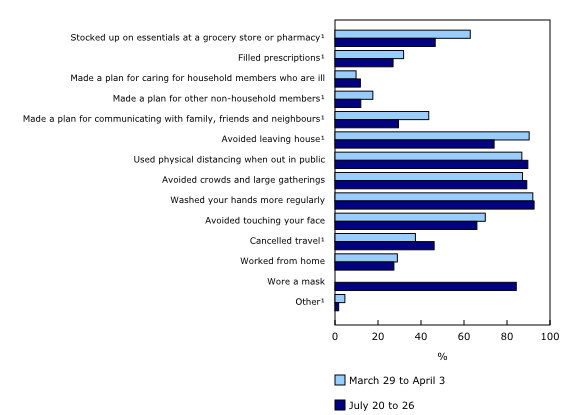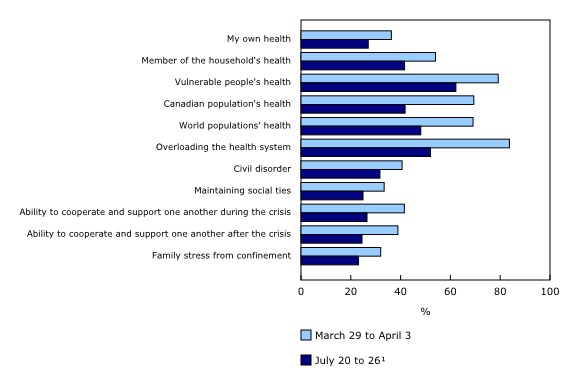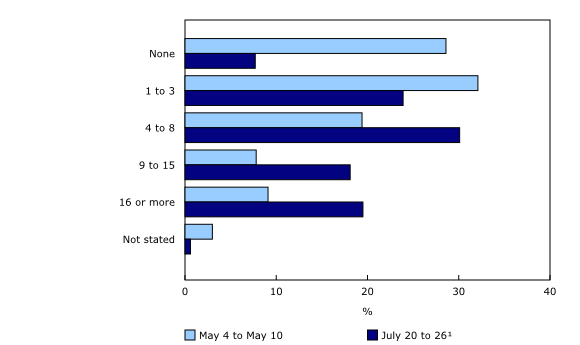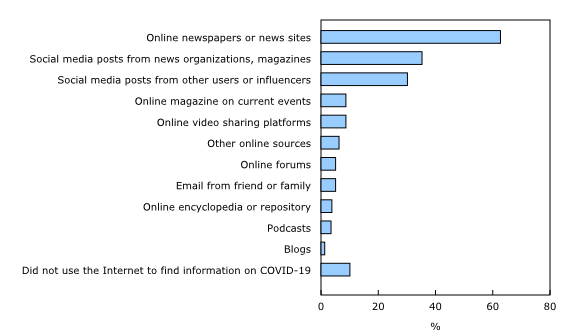Canadian Perspectives Survey Series 4: Information sources consulted during the pandemic, July 2020
Archived Content
Information identified as archived is provided for reference, research or recordkeeping purposes. It is not subject to the Government of Canada Web Standards and has not been altered or updated since it was archived. Please "contact us" to request a format other than those available.
Released: 2020-08-17
With the loosening of restrictions that were put in place to mitigate the spread of COVID-19 and the arrival of summer months, many Canadians may have recently found a greater semblance of normalcy in their daily lives. The pandemic, however, is still with us, and continues to affect Canadians across the country.
Since the beginning of the pandemic, Statistics Canada has conducted a series of web panel surveys on a regular basis to see how Canadians were reacting to the pandemic, via a new series called the Canadian Perspectives Survey Series (CPSS). For the most part, the same respondents are followed over time, and all of these surveys are statistically representative of the Canadian population.
In the most recent version of the CPSS, conducted from July 20 to July 26, a number of questions were repeated from previous CPSS surveys in order to see how Canadians are feeling relative to the beginning of the pandemic, and whether they continue to adhere to recommended safety precautions. The survey also included additional questions on how Canadians were getting informed about the pandemic, with a focus on online sources.
Results indicate that Canadians continue to follow basic safety rules, but are significantly less likely to be concerned about the health and social impacts of the pandemic. The survey also finds that Canadians have considerably increased their number of social interactions since May.
Canadians continue to follow physical distancing rules
Respondents were asked if they continue to follow certain rules and guidelines, including physical distancing rules.
Results indicate that compliance with basic safety measures remains high. In July, more than 9 in 10 stated that they would continue to wash their hands more frequently, and as was the case at the beginning of the pandemic, almost all Canadians reported that they were avoiding crowds and large gatherings and keeping a safe distance from others.
In July, about 84% of Canadians said that they wore a mask or other personal protective equipment—a precaution that was not included in the survey in March/April. Over the past weeks, several jurisdictions in Canada have introduced regulations mandating people to wear a mask in indoor public spaces. In a previous survey conducted when these measures were not yet enacted (in June), 65% of Canadians reported that they would wear a mask in public places where physical distancing is difficult.
With the loosening of restrictions, a few precautions were less likely to be followed in July compared with earlier in the pandemic in March/April. For instance, Canadians became less likely to stock up on essentials (from 63% to 47%) and less likely to make a plan to communicate with family, friends and neighbours (from 44% to 30%).
Canadians report lower levels of concern about the health and social consequences of the pandemic
From March/April to July, Canadians became less concerned about the health consequences of the pandemic. Likely as a result of a decline in COVID-19 cases in June, Canadians became less worried about overloading the health system (from 84% stating that they were very or extremely concerned in March/April, to 52% in July); about the world population's health (from 69% to 48%); about the Canadian population's health (from 69% to 42%); and about vulnerable people's health (79% to 62%).
Even though Canadians became less worried about their own health and the health of other members of their household, a significant number of people remained concerned. In July, 27% of Canadians were still very or extremely worried about their health, down from 36% in March/April.
Canadians also became less concerned about social consequences. For example, in March/April, one-third of Canadians were worried about "maintaining social ties" and 4 in 10 about the "ability to support one another" (during or after the crisis). In July, around one-quarter of Canadians were still worried about these issues.
Older Canadians are more likely to report a decline in their health concerns
For the most part, the magnitude of the decline in the level of health concerns was similar across regions, immigrants and persons born in Canada, and men and women.
However, there were some differences across age groups. Older Canadians, who were far more likely to be concerned about health issues at the beginning of the pandemic, recorded the largest decline in their level of health concerns from March/April to July.
For example, in March/April, close to half (46%) of Canadians aged 65 and older reported that they were very or extremely concerned about their own health. In July, that proportion had declined to 32%.
Among those aged 15 to 34, one-quarter (25%) reported that they were concerned about their own health in July, about the same proportion as in March/April (26%).
Canadians have increased their number of social interactions
With the relaxation in restrictions and the resumption of social and economic activities, Canadians are coming into contact with more people than they did previously, outside their family bubble.
In May, close to 3 in 10 Canadians (29%) had not come into close contact with anyone other than members of their household in the last 7 days, and close to one-third (32%) had been in close contact with 1 to 3 people. Less than one-fifth (17%) said that they had been in close contact with at least 9 people.
In July, 8% said that they had not been in close contact with anyone outside their household in the past week, and 38% reported that they had been in close contact with at least 9 people.
Although the number of social interactions increased in all population subgroups, some groups remained more likely to have a higher number of social interactions than others. In July, youth aged 15 to 34 were twice as likely (45%) as those aged 65 and older (22%) to have been in close contact with at least 9 people other than their household members.
The proportion of those who came in close contact with at least 9 people in the past week was also higher among Canadian-born individuals (41%, vs. 27% among immigrants), and lower in Ontario and Quebec.
Canadians are spending less time in front of a screen
Changes are also taking place in the way that Canadians are spending their time during the pandemic.
Back in March/April, about two-thirds of Canadians indicated that they had increased the time they spent in front of a screen, either by spending time on the Internet or watching television. These numbers held steady in May, when many restrictions were still in place.
In July, the proportion of Canadians who reported that they had increased watching television or spending time on the Internet declined by significant margins, likely the result of de-confinement measures and the arrival of summer months.
While a growing proportion of Canadians reported that they had increased their consumption of alcohol or junk food in May, that proportion declined in July, to levels seen at the beginning of the pandemic.
News sites are a major source of information for Canadians during the pandemic
The need for quality information is particularly important during a pandemic. Canadians have access to a wide variety of information sources, particularly online.
Since the beginning of the pandemic, the vast majority of Canadians have used the Internet to obtain information about COVID-19. Specifically, over 60% have consulted news sites or online newspapers, and about one-third have consulted social media posts from news organizations (35%) or from other users or influencers (30%). Meanwhile, 10% did not use the Internet at all to get information about the pandemic.
However, using online sources sometimes comes with the risk of bad or fraudulent information that can be spread by users. Misinformation can be a challenge for the government and public health agencies who are trying to communicate to the public about what they can do to protect themselves from the virus, and facts about the pandemic.
Among those who used the Internet to get information about the pandemic, about 4 in 10 reported that they saw information about the COVID-19 pandemic on a daily basis that they suspected was misleading or inaccurate.
In addition, 40% of Internet users reported that they believed that information related to COVID-19 was true and then later realized that it was not. One in five Internet users confessed that they had sometimes shared COVID-19-related information that they found online without knowing about its accuracy.
Note to readers
Data in this release are from Statistics Canada's new Canadian Perspectives Survey Series (CPSS), for which a panel of Canadians has agreed to complete a number of short online surveys. The CPSS is a probabilistic panel based on the Labour Force Survey and is therefore representative of the general population. The CPSS enables Statistics Canada to collect important information from Canadians more efficiently, more rapidly and at a lower cost, compared with traditional survey methods. The first iteration of the CPSS was conducted from March 29 to April 3 and collected information from 4,600 respondents. The second iteration was conducted from May 4 to 10, the third was conducted from June 15 to 21, and the fourth was conducted from July 20 to July 26.
Contact information
For more information, or to enquire about the concepts, methods or data quality of this release, contact us (toll-free 1-800-263-1136; 514-283-8300; STATCAN.infostats-infostats.STATCAN@canada.ca) or Media Relations (613-951-4636; STATCAN.mediahotline-ligneinfomedias.STATCAN@canada.ca).
- Date modified:





